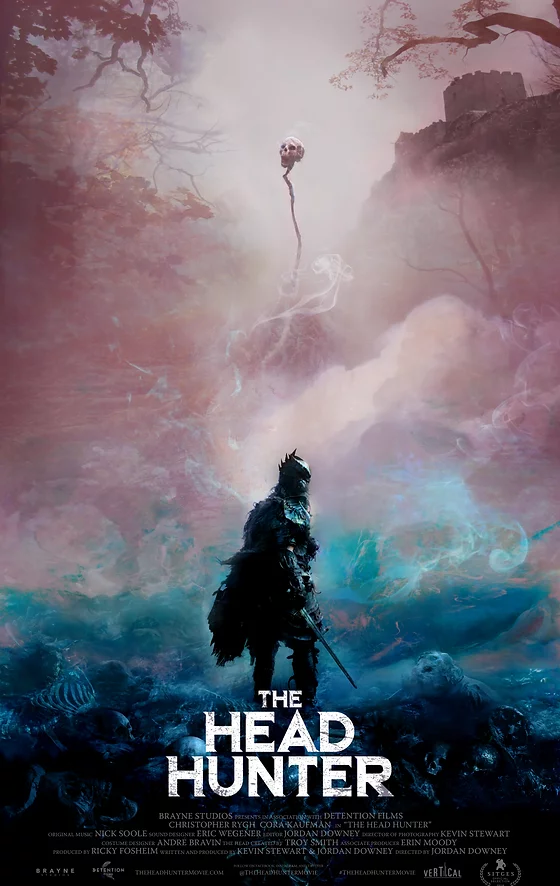The Head Hunter (2019) is the first feature film from director Jordan Downey, following a number of short projects including Critters: Bounty Hunter (2014) and Techno Western (2016), the cult hit Thankskilling (2009) and the Kickstarter-breaking Thankskilling 3 (2012).
How far would you go to avenge the death of someone you loved?
The Head Hunter 2019
Compared to these The Head Hunter is a far more serious, ambitious and rather understated exercise in dread and atmosphere. Downey takes the age-old concept of revenge and tries to make from it something of-itself and flavorful, something in some ways very unique. The trailer suggests a slow burner dark fantasy to me instantly, though its themes and setting might fool some into thinking this will be an action-packed monster slaying adventure. Admittedly, I expected to see a bit of sword swinging myself and had to quickly acclimate to what did lay in store.
Puzzle Box Horror Rating – The Headhunter 2019

IMDB : 4.5/10
Rotten Tomatoes: 94% Fresh out of 100
Rated: R
Runtime: 1 hr 12 min
Starring: Christopher Rygh, Cora Kaufman, and Aisha Ricketts
Christopher Rygh, though a little restrained at times, does well in his first feature film role to communicate the desperation of a grieving father, and the obsession of a man bent on vengeance. As the unnamed patriarch he carries out contracts delivered (by arrow) that order the deaths of monsters sighted in the castle’s surrounding forest. One of these creatures took his daughter and it doesn’t take a clairvoyant to guess where this brief (clocking at merely 72 minutes) ordeal will climax.
While minimal in plot, the film is focused enough to portray its few ideas with some effect. This is aided greatly by some impressive cinematography and elevates itself above its budget by employing quality costumes and set pieces, as well as a grim visual filter which helps immerse the viewer in its medieval darkness. Much of the monster fighting is unfortunately off-screen, which makes sense for the budget, though I am very glad the good sense was used to employ practical effects whenever one of those horrors was on display. Some juvenile part of me really wanted to see this guy crack some goblin skulls, though the tense climax involving the genuinely unsettling arch-antagonist did just about enough to satiate my bloodlust.
..The Head Hunter is rapidly gaining a cult reputation, and that’s well-deserved; this is an atmospheric, well-shot and artfully conceived number which looks great in its first UK blu-ray release..
Eddie Harrison – film-authority.com
The Head Hunter operates almost as a dark-medieval Blue Ruin (2013) with its careful drip-feed of information that keeps each snail-pace scene all the more engaging for attentive viewers. That being said, the feeling can’t be ignored that there is fat that could be cut and perhaps this particular tale would have worked better as a short film. While just scraping a feature film duration it feels as though a few ideas went underdeveloped and, although the slow pace works in its favor, a part of me persists in thinking that the third act of The Head Hunter could have been a halfway point, leading onto some obscenely violent madness. Though that could just be the idealist in me.
The Head Hunter is a tightly executed creature-feature with ambiguous implications of deep lore and hideous evil. It uses subtle foreshadowing and claustrophobic scenery to invoke palpable dread, though sadly fails to deliver enough of its promises and runs the risk of leaving viewers wanting much more. I only hope that Downey feels the same and that a similar, denser project could be on the cards.
EXCERPTS:
The Head Hunter takes the age-old concept of revenge and tries to make from it something of-itself and flavourful, something in some ways very unique.
The feeling can’t be ignored that there is fat that could be cut and perhaps this particular tale would have worked better as a short film. While just scraping a feature film duration it feels as though a few ideas went underdeveloped and the third act of The Head Hunter could have been a halfway point.
Head Hunter 2019 Trailer
Joe first knew he wanted to write in year six after plaguing his teacher’s dreams with a harrowing story of World War prisoners and an insidious ‘book of the dead’. Clearly infatuated with horror, and wearing his influences on his sleeve, he dabbled in some smaller pieces before starting work on his condensed sci-fi epic, System Reset in 2013.Once this was published he began work on many smaller horror stories and poems in bid to harness and connect with his own fears and passions and build on his craft.
Joe is obsessed with atmosphere and aesthetic, big concepts and even bigger senses of scale, feeding on cosmic horror of the deep sea and vastness of space and the emotions these can invoke. His main fixes within the dark arts include horror films, extreme metal music and the bleakest of poetry and science fiction literature.
He holds a deep respect for plot, creative flow and the context of art, and hopes to forge deeper connections between them around filmmakers dabbling in the dark and macabre.

